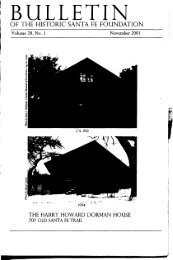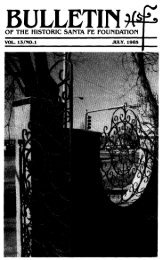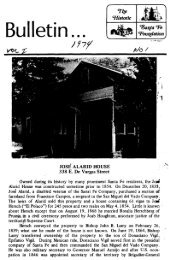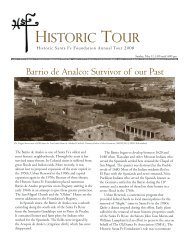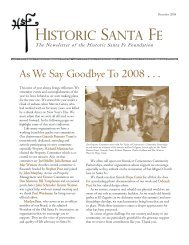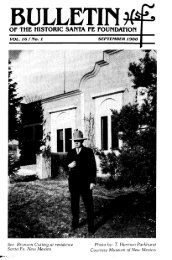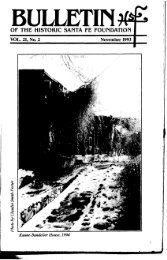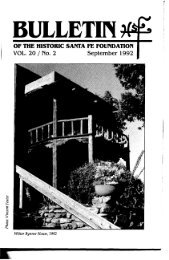Roque Tudesqui House - Historic Santa Fe Foundation
Roque Tudesqui House - Historic Santa Fe Foundation
Roque Tudesqui House - Historic Santa Fe Foundation
Create successful ePaper yourself
Turn your PDF publications into a flip-book with our unique Google optimized e-Paper software.
An excellent source of information on the historic preservation<br />
movement in the United States is the revised edition of WiIIiam 1. Murtagh's<br />
book, Keeping Time: The HistOlY and TheolJI at' Preservation in<br />
America (New York: John Wiley & Sons, Inc., 1997). Murtagh served<br />
as the first Keeper of the National Register of <strong>Historic</strong> Places and initiated<br />
preservation programs at several universities. In 1961, as vice-president<br />
of the National Trust for <strong>Historic</strong> Preservation, he spoke in <strong>Santa</strong> <strong>Fe</strong> on<br />
the importance of preservation at the time when the Trust was assisting in<br />
the founding ofthe HSFF.<br />
Q: How do historic properties get their names?<br />
Properties are commonly known by various names at different<br />
times as the result of varying associations. For example, a residence can<br />
be identified by its most recent or its most prominent occupant, its architect,<br />
or some prominent feature. An example of the latter is the "pink<br />
house" at 334 Garcia Street, so called for the distinctive color of its exteriorwalls.<br />
In preservation,<br />
a historic name is chosen which best reflects the<br />
property's history and its era of significance, which is generally earlier than<br />
50 years. (The evolving concept of significance in preservation will be<br />
discussed in more detail in a future column.) In the case of a residence, the<br />
historic name might be that ofthe person who was responsible for building<br />
the house or brought it to its present (and historic) appearance. If a<br />
building has been altered to the extent that it no longer conveys historic<br />
associations, it would not be eligible for designation, regardless of significance.<br />
Thus, to return to the example of the "pink house," its historic<br />
name is the Frank Leonard Smith <strong>House</strong> for the young man whose financial<br />
circumstances in 1920 permitted him to hire the most prominent architect<br />
of the period, Isaac Hamilton Rapp, to design the residence. Although<br />
Smith died young and is hardly known today, he was responsible<br />
for the creation of the home, which when listed remained essentially as<br />
Rapp designed<br />
it.<br />
45




